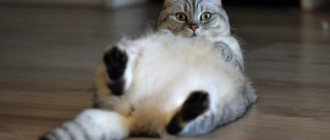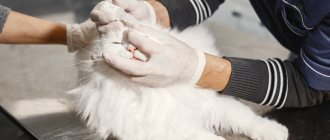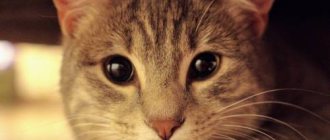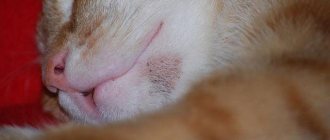11419Pavel
1
When deciding for the first time to start breeding Scottish Fold cats for commercial purposes or for themselves, the owner must know exactly everything about the birth of kittens. In most cases, the birth of a Scottish cat takes place without complications, and the four-legged mother only needs the support of the owner for a more comfortable birth of the kittens.
During pregnancy, a cat requires high-quality nutrition and careful monitoring of its condition. If the mating was the first and the Scottish female is still too young, she can give birth to only one kitten.
More mature cats that give birth more than once give birth to 5 to 7 kittens. The duration of labor in a normal course can last up to a day. Pregnancy lasts from 56 to 71 days, most often the birth of kittens occurs on the 65th day.
© shutterstock
Preparing the birth site
For the normal birth of kittens, a fold-eared cat, like any other, requires comfortable conditions. The birth box should be prepared in advance so that the pet has time to get used to it. It is very important that the environment in which the cat will give birth is homely and familiar to her. The birth box needs at least the following dimensions :
- length – 60 cm;
- width – 50 cm;
- height – 50 cm.
If the cat is very large, a larger box may be required. It is best to make one of its walls removable. This will allow, after the kittens are born, to carry out all the necessary actions to keep the bedding clean with the least amount of worry, and will also prevent the cat from jumping into the box from above, during which she could accidentally injure, or even kill, the kitten. The ideal bedding would be a thick layer of newspaper.
The kitten birth box should be placed in a warm, dry room in a dark place. The birth should take place without people or animals being strangers to the cat, which can become an additional source of stress for the Scottish cat, which will make the birth process more difficult.
Postnatal care
Half a day or a day after birth, you need to call a doctor to examine the mother. He will look to see if there are any more cubs in the womb and test the quality of the milk.
In the first 7 days, the animal’s temperature should be measured, if it is not lower than 39.4 C, this fact means there are problems. Postpartum discharge of blood or grass-colored fluid that lasts up to 3 weeks is considered normal.
If there is pus in them and they last longer than indicated, you need to contact a veterinary clinic.
A nursing pet should be walked only under supervision, because if she comes into heat and mates, she will become pregnant again, and this can significantly undermine her health.
First signs of labor
The first signs of labor in a Scots cat can be seen just before the kittens appear. It would not be amiss to note that in a British cat everything happens in a similar way. In the period before birth, about 30 hours before it, the cat's rectal temperature changes and is only 37 degrees instead of 38.6 (as usual), but it recovers within a few hours. This sign of approaching labor can sometimes be missed due to its transience.
On the day of birth, your pet’s behavior changes, she begins to actively lick the genital area, as well as the abdomen, becomes restless, actively purrs and rummages in the prepared box or place that she herself has chosen as a birthing area. The beginning of labor for tartans is considered to be the moment the plug comes out, which can be determined by the release of bloody clots or a brown jelly-like mass.
© shutterstock
Signs of pregnancy in Scottish cats
The duration of pregnancy for Scottish women is approximately 9 weeks. Conventionally, this period is divided into 3 stages. During the first 3 weeks, the cat may develop toxicosis, in the mornings it may be tormented by nausea, and the pet will often refuse even its favorite food. The animal's nipples may change color and become pink and barely swollen. The cat will be drowsy and slightly apathetic. Already on the 15th day after the expected fertilization, you can show your pet to a veterinarian, who, using ultrasound and palpation, will confirm that the Scottish woman will soon become a mother.
By the end of the 3rd week of pregnancy, Scots babies in the mother's belly reach approximately 10 mm, their head bones develop, limbs form, and the rudiments of the brain and other internal organs form.
In the middle of pregnancy - from 4 to 6 weeks - the cat's appetite will awaken and its weight will increase. The “interesting” position will be noticeable due to the protruding belly. Your pet's nipples will become even larger than before.
Towards the end of mid-pregnancy, there is a creature inside the mother that looks like a kitten in appearance. The tongue, eyelids, and fingertips are already appearing. Bones and teeth are strengthened. The genitals develop.
The final stage of pregnancy - from 7 to 9 weeks - will begin with the gradual preparation of the cat for childbirth. The future Scottish mother will prepare a “nest” for the babies and will move less.
By the end of pregnancy, the kitten’s body length is no less than 10-14 cm. It has fur. The limbs and tail are stretched, the skin becomes stronger. The weight of a small baby is about 60-70 g, while a large baby can weigh 130-140 g.
On the eve of birth, the animal will produce colostrum, and the pet will begin to behave restlessly. Just before the X-hour (24-12 hours or later), your cat's water will break and contractions will begin.
Childbirth process
If a Scottish cat has given birth for the first time, we cannot rule out the possibility that she will get scared of what is happening and do something wrong. For this reason, you need to constantly be near your pet, calming it down and providing assistance if necessary.
The entire birth process can be divided into several stages:
- removal of the plug;
- contractions - during this period the uterus opens and the kittens line up in a certain order convenient for birth;
- pushing;
- the birth of the first kitten and subsequent ones;
- passing of the placenta.
It is important to remember that pushing continues all the time until all kittens are born.
Caring for a pregnant Scottish cat
As a rule, cats of the Scottish breed are very careful when bearing offspring: they are clean, sedentary, and rarely come into conflict with other pets living in the house. However, the owner of a Scottish Fold or Scottish Straight cat should remember these simple rules:
- The portion of food for Scottish women is increased by the end of the 3rd week of pregnancy. In this case, it is advisable to divide the entire volume of food into 4-5 equal parts. Midway through pregnancy, your cat will need half as much food as before pregnancy. At the final stage (from 7 to 9 weeks), the volume of food is reduced to the original amount;
- Cats that are accustomed to eating natural food need to include vegetables, herbs, vegetable oils, dairy products, cereals, and eggs in their diet. Sometimes you can pamper your pet with boiled sea fish. Every day it is advisable to feed the purr with high-quality meat (veal, chicken, rabbit). With a natural type of nutrition, it is advisable to give the cat multivitamins;
- Scottish females eating ready-made food can be switched to extra-premium products for pregnant and lactating cats;
- Cats should not be treated with medications without the consent of a veterinarian. Even a harmless medicine can harm babies;
- Confirmation of pregnancy and counting of kittens is best left to a specialist. Too zealous independent palpation often leads to intrauterine injuries;
- It is not recommended to let a pregnant Scottish woman go outside, where she can catch an infection;
- It is extremely undesirable to make a cat expecting offspring nervous. Fear and stress often lead to early labor, and therefore the health of premature kittens may suffer. Moving, rearranging furniture, a new pet, loud music - all this can unsettle a cat;
- When the Scottish cat’s pregnancy comes to an end, you should agree with the veterinarian about providing assistance if something during the birth does not go according to plan (the kitten will walk not with its head, but with its paws; the size of the baby will be too large given the miniature dimensions of the mother, etc. ).
Owner's actions during childbirth
If cats are bred by a cattery, then giving birth to a cat is nothing new for the owners, and they can accurately and quickly do everything necessary. Those who are giving birth to a Scottish cat for the first time need to prepare everything they need in advance and remember exactly the order of their actions.
It is important to calm the pet down and lay it on its side, as this position is the safest for newborn kittens and most comfortable for the cat. If the Scottish female tries to sit up, which sometimes happens in first-time mothers, this should be prevented, since otherwise both the kittens and the mother will be injured. Childbirth in a Scottish Fold cat usually takes place without extreme situations, which does not happen with all breeds.
As soon as the pet begins to give birth and contractions appear (they can be determined by the wave-like movements of the abdomen), she should be injected subcutaneously with 1 ml of Traumatine and Gamovit. You should not combine medications in 1 syringe. This is required to facilitate childbirth and quickly recover after it.
The first kitten born immediately begins to suckle from its mother, which stimulates labor and facilitates the birth of other kittens.
© shutterstock
How often can a cat give birth?
Our Scottish cat gave birth to her last kittens at the end of January, how long before she can have kittens again without damage or wear and tear on her health? (I understand that she can bring kittens every three months, but. Tatyana.
How often a cat should give birth is a controversial issue. Veterinarians believe that breeding should occur during estrus, i.e. 1-2 times a year. Clubs adhere to a specific mating plan, which may differ from the cat’s estrus schedule.
You can often hear the following opinion: “Endless childbirth exhausts the cat’s body! She needs rest! We should try to give birth like this ourselves!” Comparing cats and people is fundamentally wrong. The difference in physiology cannot be ignored. Cats do not have “critical days” - a mechanism for cleansing the body of unfertilized eggs, like humans do. And empty heat is not “rest”: the cat suffers, screams, eats nothing, rapidly loses weight and goes bald. An exhausted, thin, shabby creature with a damaged psyche is a “rested cat”!? In addition, empty heats provoke various diseases. Sometimes empty heat undermines health more than childbirth.
Some responsible breeders do the following: their cat gives birth 3-4 times a year. But at the same time, they carefully monitor the health of their pet - regular observation by a veterinarian, diagnostics, special good nutrition, and, most importantly, a course of restorative therapy after birth, vitaminization of the body. With this approach, both the cat is in good physical shape and the kittens are born strong and healthy.
If a cat gives birth difficultly (sometimes not without the help of surgical intervention), the kittens are born weak, with pathology, then, of course, the owner should think about castration.
How often can a cat give birth? The determining factor is your well-being
Source
Helping a newborn kitten
When talking about how a Scottish cat gives birth, one cannot lose sight of the moment of providing assistance to a newly born kitten. Babies are born in a bubble, and if the cat does not immediately begin to care for them, the owner must do everything.
The sequence of actions will be as follows:
- rupture of the bladder at the level of the kitten’s nose;
- removing mucus from the nasal passages using a syringe (the nozzle of the syringe is carefully placed against the nostril and the mucus is sucked out, the procedure is carried out for both nostrils);
- dispersing blood from the umbilical cord with your fingers towards the kitten’s stomach;
- cutting the umbilical cord at a height of 2 cm from the baby’s tummy (you can rub the umbilical cord with your nails);
- Drying the newborn with a clean soft cloth.
Special veterinary training is not required for these manipulations. A healthy kitten begins to squeak and move actively as soon as it is dried.
After giving birth, the cat’s behavior returns to normal, and she begins to take care of the babies , which she was not interested in at the first moment after their appearance, due to a stressful state.
Possible complications
Childbirth does not always go flawlessly. Unforeseen and not very pleasant consequences may develop.
The cat cannot give birth to her first kitten
It happens that at the beginning of labor a problem arises with the very first baby. Perhaps the fetus is large, or its location is not normal. When the process has been going on for an hour, and the cat cannot give birth, it is necessary to urgently call a doctor.
If the baby gets stuck, the mother in labor will need help. In this situation, the cat owner must:
- Take Vaseline oil into a pipette and lubricate the birth canal.
- When the presenting part of the kitten appears, immediately press on the part of the perineum located below the anus.
- Grab the animal by the skin in the withers area (through a sterile cloth) and, while the cat is pushing, slightly pull it towards you.
- Gently hold the baby's head between your fingers;
- start shaking back and forth (like “chopping wood”), after every 3-4 shakes, rub the kitten’s chest, blow into the nose;
- Place the squealing baby next to the mother.
It is better to immediately place the successfully extracted animal in the mother's body; she will do the rest herself. If the Scottish cat does not lick the newborn, he needs to be wiped with a damp cloth, his nose and mouth should be freed of mucous masses using a small enema and placed back with the cat.
Dead kittens
If the newborn is not breathing, you can try to bring him back to life. The cat owner will have no more than 5 minutes to do this. If during this time the animal does not give a voice, further resuscitation will be useless.
The sequence of actions is as follows:
If the baby does not come to life, you can apply cotton wool with ammonia to his nose. The most radical way is to dip the kitten alternately in warm and cool water. This stimulates the heartbeat. The revived baby's nose and tongue turn pink.
It happens that a cat does not want to lick a child who has already been in the wrong hands. In this case, you need to take a piece of damp gauze, massage the baby's anorectal area to induce bowel movements, and place the baby again next to the cat.
The placenta did not come out
If after the birth the cat is in a nervous, restless state, there may be some placenta left inside. This can lead to the development of inflammatory processes and intoxication.
You should call a veterinarian as soon as possible. No animal owner can cope with this problem on their own.
Prolonged labor
If all the signs of the first stage of labor are observed, the animal is suffering, but does not give birth, despite strong attempts, the help of a doctor will be needed. The cat should be taken to the clinic as soon as possible and x-rayed.
Signs of prolonged labor are:
- absence of kittens 1–2 hours after the start of the process during strong contractions;
- the appearance of sudden weakness in a cat against a background of elevated temperature (40°C or more).
If bleeding starts and does not stop within 5–8 minutes, you should urgently call a doctor. The best option would be to transport the cat to a veterinary clinic.
Newborns
During the first 21 days of life, normal cubs only feed on milk and doze. In most cases, the mother independently looks after the babies and their bed. After the first week, kittens begin to develop eyes. They begin to fully see the world around them by two weeks. All newborns have heavenly colored eyes.
It is replaced with a permanent one in the third month. Babies' ears open on the 5th-8th day after birth, and straighten after 2 weeks.
The fluffies try to get up from the age of 18 days, and after another four days they can walk. From now on, they can eat from a plate themselves. If possible, you should not disturb the kittens again before they learn to crawl, since the mother will worry if someone touches her babies.
It is believed that the Scottish baby, caressed by people, will not get along well with his mother and the entire litter in the future. But if there is no communication with a person at all, the animal may show fear and anger, and become a slob.











